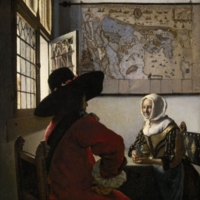Paintings Utilizing Optics
Raphael (1483-1520) is regarded as a member of the High Renaissance, known best for his architectural and painting skills. When thinking of Raphael the first thing that comes to mind is his level of accuracy and detail within his paintings. He is praised for his ability to accurately capture light and shadow as well as his use of color (1). The Expulsion of Heliodorus from The Temple is a perfect example of Raphael's painting skills. Though he was not just talented, Raphael had an understanding of optics and used this knowledge to create more realistic works of art that had a great amount of depth and detail to them. When thinking of Raphael it is fair to argue that he was a scientific painter, similiar to Leonardo da Vinci, training his eye to portray what he saw rather than what he knew or perceived as real. Raphael's paintings have a close relation to nature, which is what makes the capturing of light and shadow so realistic (1). We can see in The Expulsion of Heliodorus from The Temple, how Raphael implemented his knowledge of optics. The colors lose their vibrancy and become more muted as you go further back into the painting, this creates a sense of space and gives the idea of depth. The scale of the people also aides in this, having the largest people in the foreground and the smallest in the background. This was innovative for the time as many artists would depict the most important person in the image as the largest, even if that was not an accurate representation. Here we can see figures of importance in the background that are smaller than those in the foreground as Raphael was not concerned with conveying their importance through size but rather utlizing optics to create an overall uniform composition that depicts a scene. Zaccolini discusses Raphael's naturalistic depiction of light and shadow in his treatise, Trattato di Prospettiva (1).
Citations:
1. Janis Bell, “Re-visioning Raphael as a ‘Scientific Painter,’” in Reframing the Renaissance: Visual Culture in Europe and Latin America 1450-1650, ed. Claire Farago (New Haven: Yale University Press, 1995), 91-111
This work is another example of Raphael's understanding and implementation of optics. This is a night scene that carefully captures light within the dark setting. Raphael uses the light from the moon to strategically light the sky behind the two guards so that theor contours are visible.
One artist that was said to have been greatly influenced by the work of Matteo Zaccolini, is Nicolas Poussin. Poussin studied the work of Zaccolini, specifically the fourth volume of his treatise on the origin of cast shadows. Poussin's careful rendering of light from multiple light sources is due to his understanding of optics he learned from studying scholars like Matteo Zaccolini and Leonardo da Vinci (1).
Citations:
Elizabeth Cropper, "Poussin and Leonardo: Evidence from the Zaccolini MSS," Art Bulletin 62, no. 4 (1980): 570.
This is another example of Nicolas Poussin's use of optics.
Johannes Vermeer's (1632-1675) painting Officer and Laughing Girl has been a topic of debate for decades. When analyzing the painting it becomes evident that Vermeer used his understanding of optics to create depth within the work and form an overall more realistic looking painting through his treatment of color, light and shadow. The topic of controversy surrounding this painting (and many other works by Vermeer) is whether or not he used optic instruments to aid in his creation of the work. There is no physical proof that Vermeer used a camera obscura to create Officer and Laughing Girl, however it is widely believed that he did. At the time many artists depicted what they knew rather than what they saw . Here we can see that the officer is disproportionately larger than the girl, this is something common in photographs when one person is closer to the camera than the other, however, it was unkown to most artists of this time period (1). This is indicitave of his use of a camera obscura to render a more realistic image. Further evidence is seen in the precise convergence of parallel lines, precise reflections, and the careful slight variations of color (2). Scholars debate the extent in which they believe Vermeer used optic instruments. Some scholars argued that he projected images directly onto his canvas, while others say he projected them onto paper and then copied them over onto canvas (3). There are many contrasting ideas on Vermeer's use of the camera obscura. Some scholars believe that he knew of the camera obscura and the way it worked, however, he would not have been able to project this image because it would have been too dark or too large scale of an image. These scholars argue that Vermeer implemented techniques similar to what you would see from the use of a camera obscura, doing so without the optical instrument but solely with his knowledge of optics (3).
Citations:
1. A. Hyatt Mayor, "The Photographic Eye," Bulletin of the Metropolitan Museum of Art, New Series, Vol. 5, No. 1. (Summer, 1946), 15-26.
2. Lawrence Gowing, Vermeer (London: Faber & Faber, 1952).
3. H. Schwartz, "Vermeer and the Camera Obscura," Pantheon, xxiv (May-June 1966): 17o-82f.
Andrea Pozzo uses optics to create the illusion of depth within this work. Located on the ceiling, so when viewers look up it appears as though they are looking into a deep and continous sky, when in reality they are not. Pozzo's use of perspective and color help to create this illusion and trick the eye into seeing a deep space.

